 W
WThe coat of arms of Åland features a golden red deer on a blue field. This is traditionally surmounted by a comital coronet of the elder Swedish style.
 W
WThe coat of arms of Antigua and Barbuda was designed in 1966 by Gordon Christopher. It was officially introduced on 16 February 1967. The symbolism of the arms is more complex than that found on the Flag of Antigua and Barbuda, but many elements are similar.
 W
WThe coat of arms of the German state of Baden-Württemberg features a greater and a lesser version.
 W
WThe coat of arms of the London Borough of Barnet is the official coat of arms of the London Borough of Barnet. It was granted on 1 January 1965.
 W
WThe coat of arms of Barrow-in-Furness is the official symbol of Barrow Borough Council, the governing body of the Borough of Barrow-in-Furness, England. The arms were officially granted on 13 December 1867 to the County Borough of Barrow-in-Furness. Upon the amalgamation of the County Borough and adjacent Dalton-in-Furness Urban District on 16 April 1975 the arms were adopted by the Barrow Borough Council.
 W
WCoat of arms of the London Borough of Bexley is the official coat of arms of the London Borough of Bexley, granted on 20 May 1965.
 W
WThe Coat of arms of Bradford City Council was granted in 1976. The present City of Bradford was created in 1974 by the Local Government Act 1972 and is one of five metropolitan boroughs of West Yorkshire. The 1976 arms are based on those of its predecessor, the county borough of Bradford.
 W
WThe coat of arms of British Columbia is the heraldic symbol representing the Canadian province of British Columbia. The arms contains symbols reflecting British Columbia's British heritage along with local symbols. At the upper part of the shield is the Union Jack, representing the United Kingdom. The lower portion of the shield features a golden sun setting into the ocean, representing the province's location on the Pacific.
 W
WBrochwicz is a Polish coat of arms. It was used by several szlachta families.
 W
WThe coat of arms of Burnaby was granted originally to the Corporation of the District of Burnaby by the Canadian Heraldic Authority in 1991, and then reconfirmed for the City of Burnaby in 2005 as the Corporation's successor. The grant included the full coat of arms as well as a flag and a badge, both derived from the arms.
 W
WThe coat of arms of Chile dates from 1834 and was designed by the English artist Charles Wood Taylor (1792–1856). It is made up by a figurative background divided in two equal parts: the top one is blue and the bottom, red. A five pointed white star is in the centre of the shield. This background is supported in one side by a condor, the most significant bird of prey from the Andes, and in the other, by a huemul, a mammal endemic to Chile. Both animals wear golden naval crowns symbolising the heroic deeds of the Chilean Navy in the Pacific Ocean.
 W
WThe arms of the city of Edinburgh, more properly the arms of the city council, were registered with the Lord Lyon King of Arms in 1732, having been used unofficially for several centuries previously. The central symbol is a heraldic castle, representing Edinburgh Castle.
 W
WThe coat of arms of the London Borough of Enfield is the official heraldic arms of the London Borough of Enfield, granted on 15 August 1966.
 W
WThe coat of arms of the London Borough of Hillingdon is the official symbol of the London Borough of Hillingdon. They use elements from the coats of arms of the four previous districts. It is described as:Arms: Per pale Gules and Vert an Eagle displayed per pale Or and Argent in the dexter claw a Fleur-de-lis Or and in the sinister claw a Cog-Wheel Argent on a Chief Or four Civic Crowns Vert. Crest: On a Wreath of the Colours issuant from a Circlet of Brushwood Sable a demi-Lion Gules with wings Argent the underside of each wing charged with a Cross Gules and holding between the paws a Bezant thereon a Mullet Azure. Supporters: On the dexter side an Heraldic Tiger Or gorged with an Astral Crown Azure and charged on the shoulder with a Rose Gules charged with another Argent barbed and seeded proper and on the sinister side a Stag proper attired and gorged with a Circlet of Brushwood and charged on the shoulder with two Ears of Rye slipped in saltire Or. Motto: Forward.
 W
WThe seal of the Territory of Idaho was adopted in 1863 and redrawn several times before statehood in 1890. The state Great Seal was designed by Emma Edwards Green, the only woman to design a state seal.
 W
WThe flag and the coat of arms of Kelantan are state symbols of Kelantan, Malaysia. Like the flag of Kedah, the Kelantanese flag is red with a single charge from Kelantan's coat of arms, albeit partially.
 W
WThe coat of arms of the Komi Republic, designed by A. Neverov, was instituted by the law No. XII-20/1 on June 6, 1994 and reflects the mythic beliefs of the Komi peoples. The blazon has a gules field, featuring an or bird of prey with the face below corresponding with goddess Zarni An, and six unhorned elk heads. On December 17, 1997 the Republican State Council passed the law, which changed the official coat of arms definition in order to agree with the rules of heraldry.
 W
WThe coat of arms of the Lublin Voivodeship is Gules a stag springing Argent gorged with a coronet Or.
 W
WThe Great Seal of the State of Maine was adopted in June 1820. The concept of the design is attributed to Dr. Benjamin Vaughan of Hallowell, Maine, while the original sketch is credited to Bertha Smouse, the step-daughter of Col. Isaac Reed of Waldoboro, Maine, who purportedly wrote its official description and explanation. There have been variations in the details of the seal, but the overall design and images remain true to the original. The center of the seal is a shield adorned with a tranquil scene of a moose resting in a field bordered by water and woods; a pine tree stands tall directly behind the moose. On either side of the shield, a farmer rests on his scythe, and a sailor leans on an anchor. Above the shield is the motto "Dirigo" and a stylized North Star. Below the shield is a banner that reads "Maine". The legislature of 1919 decided that the design of the seal should no longer vary, and the design is still used today.
 W
WThe Coat of arms of Malacca is the official emblem of the Malaysian state of Malacca. The various colours on the arms indicate that the state is part of Malaysia. The star and crescent, which stand on the crest represents Islam, the official religion of the state.
 W
WThe coat of arms of Mauritius are stipulated in the "Mauritius Laws 1990 Vol.2 SCHEDULE ". In the lower left quarter is a key and on the right-hand side is a white star, which are referred to in the Latin motto "Stella Clavisque Maris Indici" meaning "Star and Key of the Indian Ocean".
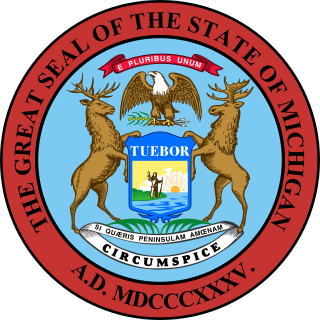 W
WThe Great Seal of the State of Michigan depicts the coat of arms of the U.S. state of Michigan on a light blue field. On the dark blue shield the Sun rises over a lake and peninsula, a man holding a long gun with a raised hand represents peace and the ability to defend his rights. The elk and moose are symbols of Michigan, while the bald eagle represents the United States.
 W
WThe coat of arms of Nizhny Novgorod is the official symbol of the city from December 20, 2006.
 W
WThe original coat of arms of New Brunswick was granted to New Brunswick by a Royal Warrant of Queen Victoria on May 26, 1868. The provincial flag is a banner of the arms.
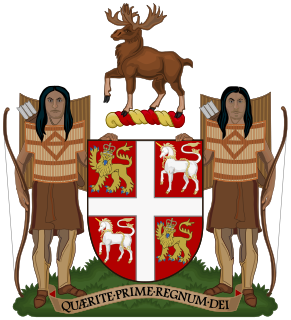 W
WThe coat of arms of the province of Newfoundland and Labrador was originally granted by Garter King of Arms, during the reign of King Charles I of England, on 1 January 1637/8.
 W
WThe coat of arms of the Government of Northern Ireland was granted to the Executive Committee of the Privy Council of Northern Ireland in 1924.
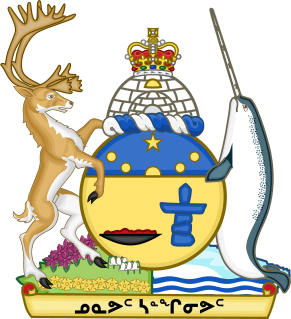 W
WThe coat of arms of the territory of Nunavut was granted by a warrant of Roméo LeBlanc, Governor General of Canada, dated 31 March 1999, one day before the territory of Nunavut, Canada, was created. The same document specified the flag of Nunavut.
 W
WÖland is a province of Sweden and, like many of Sweden's provinces, was granted a coat of arms in preparation for the funeral of Gustav Vasa in 1560. Confusion arose between Öland's arms with one deer and Åland's arms with two deer and nine roses, resulting in Öland bearing the wrong coat of arms from the 1880s until an audit in 1944.
 W
WThe coat of arms of Ontario is the heraldic symbol representing the Canadian province of Ontario. The arms contains symbols reflecting Ontario's British heritage along with local symbols. At the upper part of the shield is the red cross of St. George, representing England. The lower portion of the shield features three golden maple leaves on a green background.
 W
WThe Seal of the State of Oregon is the official seal of the U.S. state of Oregon. It was designed by Harvey Gordon in 1857, two years before Oregon was admitted to the Union. The seal was preceded by the Salmon Seal of the Provisional Government and the Seal of the Oregon Territory. The state seal is mandated by Article VI of the Oregon Constitution.
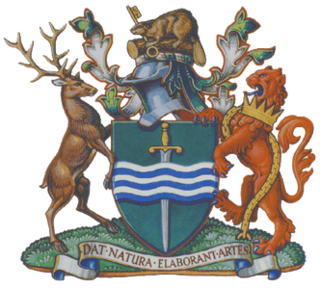 W
WThe coat of arms of Peterborough, Ontario, was adopted on 7 May 1951.
 W
WThe coat of arms of the Polish city of Piła features a red deer on a green field, leaping to the dexter. It was first featured on a seal of the city council created probably in 1571. Initially, the deer was leaping towards the sinister side of the shield; this was changed in the 17th century. During the Partitions of Poland the local German authorities sometimes also used a modification of the coat of arms featuring a crowned deer.
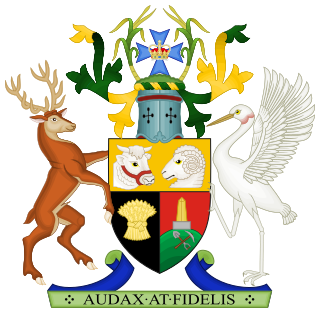 W
WThe coat of arms of Queensland is the oldest in Australia, and was first granted by Queen Victoria in 1893 through the simplest form of heraldic grants; with the shield of arms, motto, helmet, mantling and crest.
 W
WThe coat of arms of Saskatchewan is the heraldic symbol representing the Canadian province of Saskatchewan.
 W
WThe coat of arms of South Georgia and the South Sandwich Islands was granted in 1985, upon the creation of the territory. Prior to 1985, South Georgia and the South Sandwich Islands were a dependency of the Falkland Islands, and used their coat of arms. However, prior to 1962, the islands were grouped with what is now the British Antarctic Territory and their coat of arms was used instead of the Falkland Islands’ arms.
 W
WThe coat of arms of Vermont is the official armorial bearings of the U.S. state of Vermont. Most of the elements found in the coat of arms originate in the Great Seal of Vermont designed by Ira Allen. Whereas the Great Seal of Vermont is reproduced in a single color and is reserved for embossing and authenticating state documents, the coat of arms is a more naturalistic and colorful representation of many of the same elements. The Coat of arms of Vermont was first used in 1807 on $5 bank notes of The Vermont State Bank. One of these notes is in the special collections of the Vermont History Center in Barre, Vermont. Prior to the discovery of the 1807 banknotes, the earliest representation of the coat of arms of Vermont was found on an engraved 1821 state military commissions. The exact designer is not known, but it is likely that then Secretary of State Robert Temple worked with an engraver in developing the arms. Considerable liberties were taken in early depictions of the coat of arms. The location of the cow and the sheaves moved about the foreground, and the height of the pine tree and size of the buck's head also varied. A state statute was approved in 1840, and modified in 1862, both attempts to codify and create more consistent representation of the arms. The coat of arms was cast in brass to ornament uniforms of Vermont's military regiments before, and through the U.S. Civil War, when individual states raised and trained their own regiments.
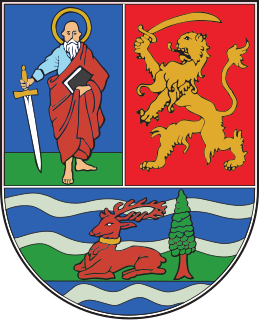 W
WThere are two coats of arms in official use in the Autonomous Province of Vojvodina, the Coat of arms of Vojvodina and the Traditional coat of arms of Vojvodina. Two coats of arms are given the equal status in the Provincial Assembly Decision on the Appearance and Usage of Symbols and Traditional Symbols of AP Vojvodina adopted in 2016.
 W
WThe coat of arms of the Kingdom of Württemberg shows an impalement of the three black antlers that represent Württemberg on the dexter side, and the three black lions passant of medieval Swabia on the sinister side, both on a gold field.